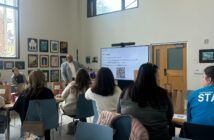Red wine, white tank tops and smudged eyeliner are now over. This summer, Brat Summer sent cultural shockwaves via TikTok dances to Charli XCX’s song “Apple,” brat-related Instagram marketing and election ads deeming Kamala Harris “brat.”
Though some of these fads are no longer trending, “Brat,” Charli XCX’s newest album, and Brat Summer signal a new wave of pop music, specifically that of the up-and-coming artists and producers Charli XCX surrounds herself with.
This musical shift has revamped the club culture that existed in the mid to late 2000s, which people online have taken to calling “indie sleaze.”
Brat reads as a love letter to underground British party culture and Sophie Xeon, a Grammy-nominated experimental pop producer, recording artist and close friend of Charli XCX who passed away in 2021.
Xeon spent her career innovating in the pop sphere, leading to a blow-up of what is now called “hyperpop.” “Brat” follows in her footsteps and pushes the trend of a bizarre girlification of pop, which for the last decade has been a genre devoid of mess.
The era of perfectly polished radio hits is quickly coming to an end, as older artists like Katy Perry struggle to maintain relevancy and have abandoned their original styles to try to emulate newer pop artists like Charli XCX.
We’re experiencing a renaissance of pop music in other acts like Chappell Roan and Sabrina Carpenter. But they are not just making music. They are crafting a character and a world in which their music exists.
The limited number of artists performing in this way is why we have not had a true pop star since the early 2010s, with the likes of Lady Gaga, Ke$ha and Perry.
Someone who has captured this new pop aesthetic better than anyone is Harrison Patrick Smith, known professionally as The Dare. He recently gained a second wave of popularity after producing the song “Guess” on Charli XCX’s newest album and subsequently becoming a part of her entourage.
He can often be seen bopping his head in the background of TikToks — often accompanying Charli XCX behind a DJ booth — and is instantly recognizable because of his signature uniform — a black suit and tie.
As most do, I first discovered Smith through TikTok where he was promoting his then not yet released single “Girls” in the summer of 2022. That same summer, I followed the Instagram page @indiesleaze and read about surviving the vibe shift in The Cut.
This renaissance of “indie sleaze” and late 2000s indie club culture, was once just called “hipster” culture. Now, it feels like the epitome of the infamous “the chicken or the egg” question.
I’ve been hearing about its return since the end of the pandemic, but the characteristics of it are just starting to appear, often in a costumey, semi-ironic way. Almost no one is engaging in these trends in earnestly.
The Dare released his first album, “What’s Wrong With New York?,” this year on Sept. 6. But from the way it sounds, this album could’ve been released in 2007. The name hints both at his heavy influence of early 2000s dance-pop bands like MGMT, The Rapture and LCD Soundsystem, who dominated the New York indie scene, and The Dare’s original status as a “New York darling.”
After he released his first single, he appeared on the cover of New York Magazine’s 2022 edition of their annual “Reasons to Love New York Issue,” in a Where’s Waldo-type collage with other famous New York based celebrities. The Dare promises to deliver something raw, messy, offensive and trashy — all things I think the music industry is starving for.
In its best moments, “What’s Wrong With New York?” exemplifies those characteristics. In the album’s best songs “Girls” and “Movement,” the music feels fresh and gritty. But in its worst, the album feels like a caricature of its influences.
In “I Destroyed Disco,” Smith asks in a drippingly pretentious voice, “What’s a blogger to a rocker, what’s a rocker to the Dare?” This question serves as Smith’s thesis: the idea that pop can be just as interesting, rebellious and groundbreaking as rock.
The jokey bravado behind the line matches the campy energy that the best parts of the album are filled with. However, I don’t know if the album has enough of an identity all its own to back it up.
The Dare is to LCD Soundsystem what Greta Van Fleet is to Led Zeppelin: a knockoff. Though a good knockoff, at the end of the day, wouldn’t you just rather listen to Led Zeppelin?
The average person on the street doesn’t know who The Dare is, and maybe they never will. But I think that his producing, collaboration with larger artists and this turn towards a looser, less-polished pop that people can dance to will long outshine his career.
And as he exemplifies similar 2000s-esque sounds to trending artists like Charli XCX — who seem to be a part of a microtrend that might come to an end soon — the future of the pop genre is uncertain.






Comment policy
Comments posted to The Brown and White website are reviewed by a moderator before being approved. Incendiary speech or harassing language, including comments targeted at individuals, may be deemed unacceptable and not published. Spam and other soliciting will also be declined.
The Brown and White also reserves the right to not publish entirely anonymous comments.